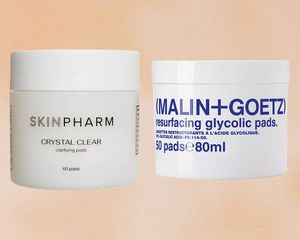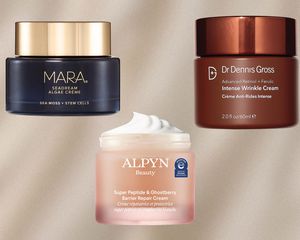:max_bytes(150000):strip_icc()/__What-is-Hyaluronic-Acid-2937-2x3-hires-4b6eca342cc24553a15b329bcfd7e0b2.jpg)
Liz DeSousa / Byrdie
When it comes to skincare fame, hyaluronic acid and retinol pretty much take the cake for most iconic ingredients—but what happens when you use them together? Can two powerhouses work together? Or will they fight for the spotlight and wreak havoc on your face?
While many of us obsess over the basics—the cleansing, moisturizing, and protecting of the skin—determining how the ingredients you’re using interact is equally as important.
We asked board-certified dermatologists Jeremy Fenton and Ivy DeRosa to help us investigate how hyaluronic acid and retinol work (or don't) as a pair. Keep reading to learn more.
Meet the Expert
- Jeremy Fenton, MD, is a board-certified dermatologist at Schweiger Dermatology Group in New York City.
- Dr. Ivy DeRosa is a board-certified medical and cosmetic dermatologist with a small private practice outside of Philadelphia.
What Is Hyaluronic Acid?
Hyaluronic acid is a hydrating ingredient that moisturizes skin, reduces the appearance of wrinkles, replenishes cell moisture, and speeds wound healing. To get more scientific about it, as DeRosa explains, "Hyaluronic acid (HA) is a molecule in a class called humectants. Their job is to help retain water in your skin." And, as we know, hydration gives skin that dewy, glowy effect we all strive for.
Hyaluronic acid "comes in many different forms over the counter, like serums or lotions and help to fill the nooks and crannies our skin develops over time due to pollution, sun damage and the normal aging process," DeRosa says, adding: "HAs don't change the architecture of your skin in the long run, as retinoids do, but they can help for a temporary improvement in the look and feel of your skin."
It’s generally safe for all skin types and has no known side effects (at least when applied topically).
What Is Retinol?
If hyaluronic acid is the popular girl who’s nice to everyone, think of retinol as her equally popular but very intimidating best friend. According to Fenton, retinol is an antioxidant that increases cell turnover, boosts collagen production, and regulates oil production—it’s regularly lauded as a godsend for anyone looking to address texture, acne, or signs of aging. It can also work synergistically, with other topicals. "Retinol may be helpful in combination with other topical treatments because it exfoliates the skin and can allow ingredients to penetrate deeper, making them more effective," says Fenton.
But retinol also comes with some serious side effects (both doctors note dryness, peeling, and irritation) and the potential for intense, prolonged purging. Hence the intimidation.
Can You Use Hyaluronic Acid and Retinol Together?
Much like the girls in our high school analogy, hyaluronic acid and retinol are a match made in heaven. Where retinol is rough, hyaluronic acid is soft; where hyaluronic acid is weak, retinol is strong. Together, they balance each other out without compromising the things that make them unique. It’s exactly what makes the combination one of the most popular across all skincare ingredients.
Key Takeaways
- Hyaluronic acid and retinol can be used within the same routine without concern for irritation.
- Due to its powerful hydrating properties, hyaluronic acid can even help mitigate the side effects of retinol.
- When using both ingredients together, apply your retinol first, then follow up with a hyaluronic acid serum.
Benefits of Using Hyaluronic Acid and Retinol Together
Like we said, hyaluronic acid and retinol are the ultimate duo. Together, they have a sort of synergistic effect, making it easier to reap the benefits of retinol without suffering any of the usual dryness thanks to the moisture boost from hyaluronic acid.
Hyaluronic acid helps keep retinol in check, increasing the permeability of the skin. So when combined, the two ingredients can leave your skin clearer, smoother, and more hydrated and moisturized. What more could you ask for?
Not to mention it’s a combination you might already be using: many moisturizers contain hyaluronic acid anyway. Likewise, DeRosa says many high-quality, over-the-counter retinol products are formulated with hydrating and calming ingredients to help mitigate irritation, so there’s a chance your retinol even contains some hyaluronic acid anyway.
Potential Side Effects
As is the case with all skincare ingredients, there’s always some sort of potential for irritation. That potential is fairly high with retinol and very low with hyaluronic acid. So, yes, there is still a chance of irritation but it is a very, very small one—and that irritation would likely be caused not by the combination of retinol and hyaluronic acid but by the retinol itself.
How to Use Hyaluronic Acid With Retinol
DeRosa provides the following timeline for application of HA and retinol products: "If dealing with sensitive or dry skin, a great way to tolerate a retinol is by first cleansing with a gentle wash; no scrubs, toners or physical exfoliants. Then apply a pea size amount (that's right- just a pea, more is not better) of retinol to the face, apply a small amount of a hyaluronic acid serum followed by a moisturizer cream. The moisturizer helps to lock in the HA so it can amplify the helpfulness of your moisturizer."
Try applying a moisturizer or hyaluronic acid in gel form around 30 minutes after applying retinol so that the treatment can dry and soak into the skin before moisturizing. For those with dry or sensitive skin, try usinga hyaluronic acid serum prior to retinol. Then, once the retinol has dried, apply a moisturizer.
How to Minimize Irritation
An important note: the importance of proper application methods when it comes to retinol and hyaluronic acid cannot be overstates. Be sure to give your retinol time to dry and seep into the skin before moving on to the next steps. This will minimize irritation.
The Final Takeaway
Not only can you use hyaluronic acid and retinol together, but both doctors actually encourage you to. And they’re not alone: Few other ingredient combinations are as well-regarded as hyaluronic acid and retinol in the skincare community.
On their own, hyaluronic acid and retinol are both considered two of the most popular ingredients in anti-aging skincare products. Because hyaluronic acid draws water into the skin while retinol speeds cellular turnover, you can counteract some of retinol’s notorious drying properties while still allowing the ingredient to penetrate the outer layer of the skin. If anything, results are only better when you combine the two. So give the combo a try—you can thank me later.


